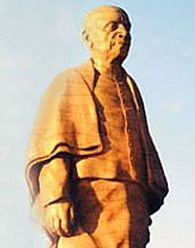 | « Back to article | Print this article |
 In a country where 68.7 per cent people live on less than $2 a day, statues are not exactly the most important task on the list.
In a country where 68.7 per cent people live on less than $2 a day, statues are not exactly the most important task on the list.
A statue won’t make our problems go away. Investing that money in better infrastructure for the physically challenged, inclusive classrooms for learning disabled children and good healthcare for the remotest of villages just might do the trick, says Paloma Sharma.
For as long as I’ve been reading the newspaper, politicians have told me that the latest statue they are erecting would stand for equality, unity, peace and all the other virtues on the list.
Statues were made, statues were named and renamed and fought over in state assemblies. Money was sanctioned, money was looted – every paisa which was tax payer money. But in my 18 years, never have I seen the equality, unity and peace that were promised (except for maybe when India played against Pakistan in the T20 World Cup cricket final).
There is talk of building a statue of an iconic leader, taller than any other statue in the world, on a small rocky island in the middle of the Narmada. Similarly, in another state, another leader had erected statues of other great men (and of herself) in order to promote a feeling of self-respect among members of her community, a community which has been oppressed ever since the Late Vedic Period.
But noble as the intentions of the heads of states and countries might have been, it is common knowledge that a mere symbol does not have the power to wipe out the grief and suspicion that groups of people have harboured against each other for generations.
I am sure that our greatly venerated leaders are wise enough to realise that in a country where 68.7 per cent people live on less than $2 a day, statues are not exactly the most important task on the list.
While it is true that symbols personify righteous ideals that citizens can look up in times of crises to be reassured of things such as hope and patriotism, those are luxuries that only the middle and upper classes can afford – not the 32.7 per cent that live under the international poverty line, not the three Dalits who get raped or the two who get murdered every day and certainly not the one woman who gets burned alive every 90 minutes due to the inability to meet her in-laws’ ever increasing demand for dowry.
These people need a whole lot more than a symbol. They need justice – social and legal – because that’s the only thing that will improve their lives.
Statues look pretty in our highly convenient urban environments. They make us feel like we remember the people who we owe our freedom to (would those people have wanted us to spend our resources on memorials instead of schools?), they fulfil that void that comes from the knowledge that we really aren’t giving back to society and sometimes, very rarely, they manage to inspire us.
But a statue won’t make our problems go away. On the other hand, investing that money in better infrastructure for the physically challenged, inclusive classrooms for learning disabled children and good healthcare for even the remotest of villages just might do the trick. Let’s give all of that a try for a change, shall we?
Paloma Sharma is college student.